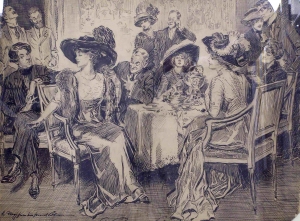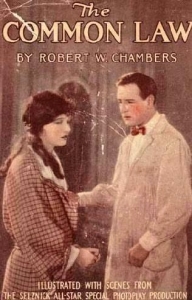
Charles Dana Gibson (1867-1944)|Her poise, her unconsciousness, the winning simplicity of her manner were noticed everywhere, 1911|Illustration for The Common Law by Robert W. Chambers (New York and London: D. Appleton and Co., 1911): 307|ink and pencil on board|Norman Rockwell Museum Collection, gift of Everett Raymond Kinstler, NRM.2009.37
Charles Dana Gibson’s images of America, especially American women, from the 1890s through 1910, defined the age contemporaneously and retrospectively. Her poise, . . . . is one of 56 drawn illustrations Gibson created for Robert W. Chambers’ 1911 novel, The Common Law. The story chronicles the tribulations of a young woman, Valerie West (the young lady pictured at the middle left of the above scene), who was left penniless after her mother dies. She supports herself as an artist’s model and becomes involved with two painters: the wealthy talented and young Louis Neville, the first artist for whom she first modeled, and the unpredictable hot-blooded Spanish painter, Querida.
On this drawing, under Gibson’s signature, is written, “At the Five Minute Club.” Chambers described the club in his novel as, “. . . a semi-fashionable, semi-artistic affair—one of the incarnations of the latest group of revolting painters and sculptors and literary people, diluted with a little society and a good deal of near-society. . . . Its devotees were the devotees of Richard Strauss, of Huysmans, of Manet, of Degas, . . . .”* In this illustration at the tea table of the Five Minute Club, Valerie West (the beautiful woman at the foreground left of the table) drew the assembly around her as they admired her poise and beauty. At this first introduction to the club, she and Neville found themselves appalled by the assembled members, where they saw those with little talent applauded others of the same.
Chambers and Gibson were long-time friends, having met while students at the Art Students’ League in New York. Chambers went on to study art in Paris and later produced illustrations for some of the major publications of the day. By the mid-1890s Chambers was focused on writing popular fiction. Over the years Gibson produced illustrations for many of Chambers’ stories and books. When Chambers wrote this story about artist studio life in New York, it was based on his own first-hand knowledge. It is interesting that Chambers expanded Valerie West’s experiences as an artist model to include posing for illustration artists:
Illustrators now clamoured for her in modish garments of the moment—in dinner gown, ball gown, afternoon, carriage, motor, walking, tennis, golf, riding costumes; poster artists made her pretty features popular; photographs of her in every style of indoor and outdoor garb decorated advertisements in the backs of monthly magazines. She was seen turning on the water in model bathtubs, offering the admiring reader a box of bonbons, demurely displaying a brand of hosiery, recommending cold cream, baked beans, railroad routes, tooth powder, and real-estate on Long Island.**
Fascinatingly, even before Gibson’s images of American women were described by his name in the popular press of the new century, independent-minded working women were often described as a “Chambers Girl.”
So popular was this novel that in 1916 Selznick Enterprises released a now lost silent movie of this story with Clara Kimball Young and Conway Tearle in the lead roles (with her real father, Edward M. Kimball playing Neville’s father); in 1923 the story was produced again with Tearle reprising his role and Corinne Griffith as Valerie West; and in 1931 it was remade with Constance Bennett as Valerie West and a young Joel McCrea as Neville.
Gibson’s rendition of the elegant tea gathering of the Five Minute Club is exquisitely detailed. On the cloth-covered tea table, the large elegant creamer and sugar stand guard in front of the tilting tea pot, which would have been necessary since the large size of the pot would have precluded lifting it to pour. In this drawing we can see the pencil lines that set the sketch and the variety of ink applications (with thin point, broad point, and even brush) used in order to create the variety of textures and the implication of distance within the scene. Gibson also spent considerable effort on the variety and details of the women’s hats. While we might wonder over the extreme size of some of these hats, indeed Gibson’s illustration was only recording the fashion of the moment. In the first decade of the 20th century women’s dresses were paired down and hems stopped at a lady’s ankles or feet. As the silhouette became slimmer, the hats brims became broader and deeper with the crown outlines often disguised by the addition of masses of feathers and even stuffed birds. Some time after this illustration was finished, Gibson gave it to fellow artist and illustrator, James Montgomery Flagg.
* The Common Law by Robert W. Chambers (New York and London: D. Appleton and Co., 1911): 304. The common law of the story’s title refers to a recognized marital relationship without the benefit of a marriage ceremony or civil contract.
** Ibid.: 167. Edouard Manet and Edgar Degas were French impressionist artists; Richard Strauss was a German romantic composer; and Joris-Karl Huysmans was a French novelist famous for his novel of decadent life À rebours, 1884, which later influenced Oscar Wilde.
March 18, 2010
By Joyce K. Schiller, Curator, Rockwell Center for American Visual Studies
at the Norman Rockwell Museum







